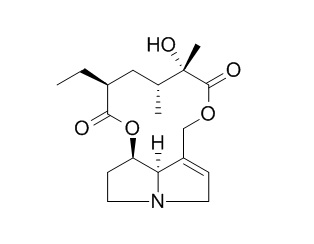Yamataimine
Reference standards.
Inquire / Order:
manager@chemfaces.com
Technical Inquiries:
service@chemfaces.com
Tel:
+86-27-84237783
Fax:
+86-27-84254680
Address:
1 Building, No. 83, CheCheng Rd., Wuhan Economic and Technological Development Zone, Wuhan, Hubei 430056, PRC
Providing storage is as stated on the product vial and the vial is kept tightly sealed, the product can be stored for up to
24 months(2-8C).
Wherever possible, you should prepare and use solutions on the same day. However, if you need to make up stock solutions in advance, we recommend that you store the solution as aliquots in tightly sealed vials at -20C. Generally, these will be useable for up to two weeks. Before use, and prior to opening the vial we recommend that you allow your product to equilibrate to room temperature for at least 1 hour.
Need more advice on solubility, usage and handling? Please email to: service@chemfaces.com
The packaging of the product may have turned upside down during transportation, resulting in the natural compounds adhering to the neck or cap of the vial. take the vial out of its packaging and gently shake to let the compounds fall to the bottom of the vial. for liquid products, centrifuge at 200-500 RPM to gather the liquid at the bottom of the vial. try to avoid loss or contamination during handling.
Int J Mol Sci.2023, 24(15):12397.
Am J Chin Med.2022, 1-20.
ScienceAsia2024, 50,2024073:1-9
Mutlu Yanic S, Ates EG. JOTCSA.2023, 10(4);893-902.
Oxid Med Cell Longev.2020, 2020:8887251.
J Ethnopharmacol.2023, 309:116302.
Appl. Sci.2020, 10(20),7374.
Separations2021, 8(7),90.
Nature Ecology & Evolution2020, doi: 10.1038
J of Engineering Science&Technology2018, 13(9):2820-2828
Related and Featured Products
Rapid Commun Mass Spectrom. 2008;22(4):591-602.
Identification of five hepatotoxic pyrrolizidine alkaloids in a commonly used traditional Chinese medicinal herb, Herba Senecionis scandentis (Qianliguang).[Pubmed:
18220326]
METHODS AND RESULTS:
Senecio scandens Buch.-Ham is a plant source for a commonly used traditional Chinese medicinal (TCM) herb Qianliguang. A TCM herbal proprietary product containing Qianliguang as the major herb for the treatment of sinusitis has been used in China for several decades, and has also been exported to other regions and countries worldwide. In the present study, the aqueous extract of S. scandens collected in the Shanxi Province of China was determined, for the first time, to contain hepatotoxic and tumorigenic pyrrolizidine alkaloids (PAs) by using high-performance liquid chromatography/mass spectrometric (HPLC/MS) analysis in various scanning modes. A total of nine toxic and two non-toxic PAs were detected in the aqueous extract of S. scandens, of which six PAs, namely neoplatyphylline, senecionine, senecionine N-oxide, seneciphylline, seneciphylline N-oxide and senkirkine, were unequivocally characterized, while other PAs were tentatively assigned as jacobine, jacozine N-oxide (or erucifoline N-oxide), 7-tigloylplatynecine, usaramine and an isomer of Yamataimine. The estimated total content of toxic PAs in S. scandens was 10.82 microg/g herb, which was significantly higher than that (> or =1 microg/g herb) recommended by Belgium and Germany not to be used clinically.
CONCLUSIONS:
Among the PAs definitively identified, senecionine, seneciphylline, and senkirkine are known tumorigens capable of inducing liver tumors in experimental animals, while seneciphylline N-oxide and senecionine N-oxide are probably tumorigenic due to their potential conversion into seneciphylline and senecionine via metabolic reduction in the body. Thus, the current finding of the presence of toxic/tumorigenic PAs in S. scandens challenges the safety of using this TCM herb and its proprietary products.
Bulletin of the Chemical Society of Japan (Impact Factor: 2.22). 11/1994; 67(11):3094-3099.
Enantioselective Synthesis of the Macrocyclic Pyrrolizidine Alkaloid Yamataimine[Reference:
WebLink]
METHODS AND RESULTS:
Described is a short-step synthesis of optically active Yamataimine, a 12-membered pyrrolizidine alkaloid of retronecine type. Methyl (1S,SR)-5-methyl-2-oxocyclopentanecarboxylate derived from (R)-(+)-pulegone was converted into the necic acid component required for the synthesis of Yamataimine, in a nine-step sequence. Regioselective coupling of (+)-retronecine with the necic acid component via tin-mediated regioselective acylation followed by macrolactonization led to the first synthesis of (+)-Yamataimine.
CONCLUSIONS:
Enantioselective Synthesis of the Macrocyclic Pyrrolizidine Alkaloid Yamataimine.



